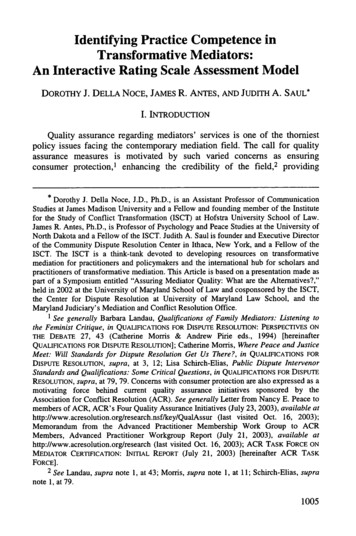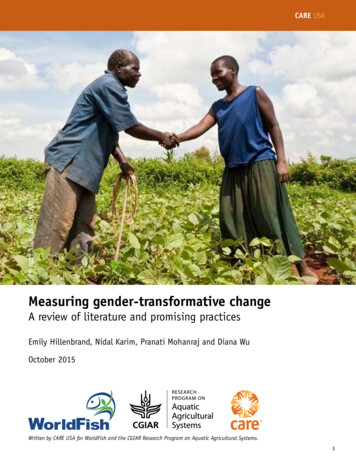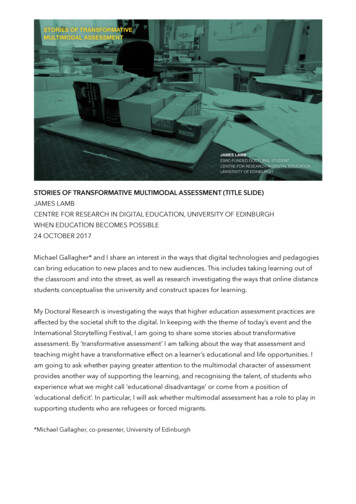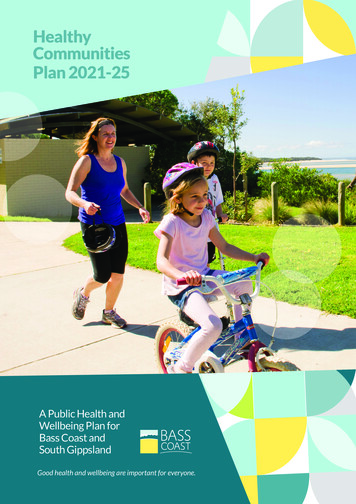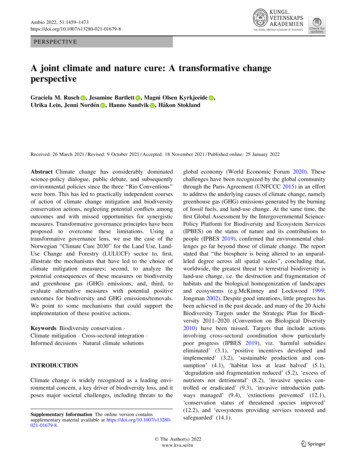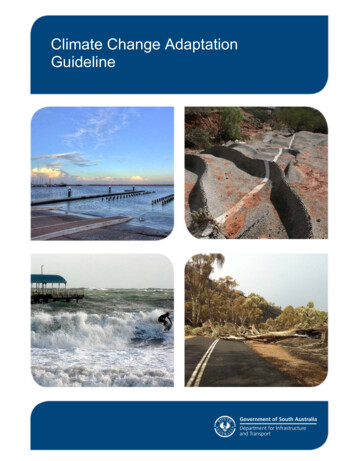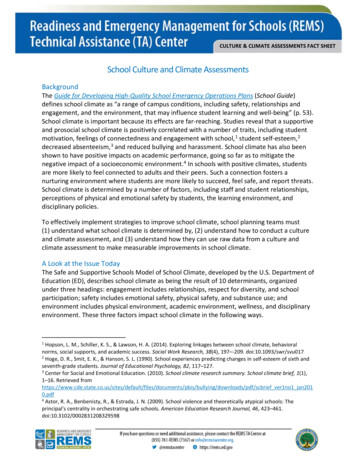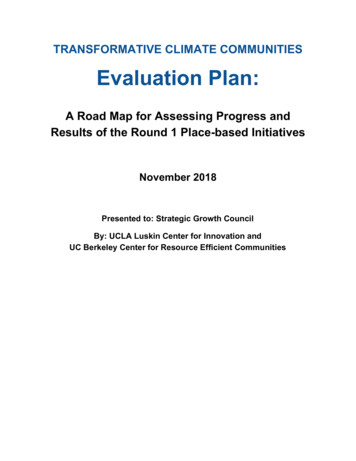
Transcription
TRANSFORMATIVE CLIMATE COMMUNITIESEvaluation Plan:A Road Map for Assessing Progress andResults of the Round 1 Place-based InitiativesNovember 2018Presented to: Strategic Growth CouncilBy: UCLA Luskin Center for Innovation andUC Berkeley Center for Resource Efficient Communities
Acknowledgements and DisclaimerAUTHORSHIPJ.R. DeShazo, principal investigatorBill Eisenstein, co-principal investigatorColleen Callahan, deputy directorJason Karpman, project manager, site manager, and researcherZoe Elizabeth, site manager and researcherKelly Trumbull, site manager and researcherLolly Lim, researcherEmma Mehlig French, researcherACKNOWLEDGMENTSThis evaluation plan was commissioned by the California Strategic Growth Council (SGC),which administers the new Transformative Climate Communities (TCC) program. The authorsthank SGC staff, current and former, for their support in the development of the plan. Thisincludes: Louise Bedsworth, Randall Winston, Saharnaz Mirzazad, Julia Nagle, RachelGalaraga, Daniela Simunovic, Marlene De La O, and Blake Deering.In addition, the authors thank representatives from other state agencies for serving on thetechnical advisory committee and sharing their intellectual expertise in support of this plan:Elizabeth Baca, Jessica Bede, Brian Bulaya, Amrith Gunasekera, Meredith Milet, CatherineOhaegbu, Jesse Torres, Joseph Wraithwall, Sophie Young.We also recognize the many advocates who helped shape the TCC program and those whoprovided feedback on a draft version of this evaluation plan. This includes members of theCalifornia Environmental Justice Alliance, who developed a clear vision on how to structure theTCC program and a framework for evaluation, as documented in the report Transformative Climate Communities Community Vision And Principles For A Successful Program, whichinformed the development of this evaluation plan.DISCLAIMERThe authors appreciate the contributions of the aforementioned agencies and individuals. Thisdocument, however, does not necessarily reflect their views. Any errors are those of theauthors. To continue to be responsive to stakeholder feedback, evolving programimplementation details and lessons learned, details of this plan may be updated over time.FOR MORE INFORMATIONUCLA Luskin Center for Innovation: www.innovation.luskin.ucla.edu UC Berkeley Center for Resource Efficient Communities: www.crec.berkeley.edu/ November 2018 by the Regents of the University of California, Los Angeles. All rights reserved.2
Table of ContentsAcknowledgements and Disclaimer21. Introduction31.1. Value of Evaluation51.2. Evaluation Framework and Definitions51.3. Complementary Objectives Achieved by TCC Program92. Overview of Evaluation Phases132.1. Baseline Evaluation132.2. Process Evaluation132.3. Outcome Evaluation142.4. Impact Evaluation143. Methods and Data Types163.1. Methods for Evaluation163.2. Secondary Data183.3. Primary Data193.3.1. User Surveys203.3.2. Focus Groups223.3.3. Interviews243.4. Estimated Data25Appendices28Appendix 1. Background Materials29Appendix 2. Indicators by Project Type and Transformative Plan33Appendix 3. Detailed Overview of Control Sites80Appendix 4. Detailed Documentation of Methods and Data Sources99Appendix 5. Primary Data Collection Instruments1083
1. IntroductionThe bold aim of the Transformative Climate Communities (TCC) program is apparent in itsname. The program aims to leverage Greenhouse Gas Reduction Fund dollars (i.e. CaliforniaClimate Investments) to transform communities that have historically experiencedunderinvestment. These communities face poverty and pollution, along with a need for morereliable transportation, affordable housing and access to fresh food. The first round of the TCCprogram will bring a wide variety of new projects and services to three sites, located in Fresno,Ontario and the Watts neighborhood of Los Angeles. No such program has ever been initiated.The Strategic Growth Council (SGC), which administers the TCC program, contracted with theUniversity of California, Los Angeles and University of California, Berkeley (UCLA-UCBevaluation team) to draft an evaluation plan for assessing TCC progress and outcomes at theneighborhood-level. The UCLA-UCB evaluation team created this plan as a guide for evaluatingthe first three TCC sites specifically as well as future TCC sites generally. This document couldserve as the foundation of future evaluation plans for other TCC grant rounds. In addition,details of this plan may be updated in response to stakeholder feedback, evolving programimplementation details, and lessons learned.The goals for implementing this plan are to track, assess and communicate local TCC progressand outcomes to stakeholders while helping to improve the design and implementation ofcurrent and future TCC supported projects. These activities are expected to provide a numberof benefits to external stakeholders, as described in Section 1.1. This document describes an approach and general timeline for TCC site evaluation, thefoundation of which is the prioritized tracking and assessing of key indicators that could changeover time due to TCC investments. The indicators contained in this evaluation plan are theresult of a planning process that took into account the TCC program framework; goals definedby the grantees; the logical chain of interim outcomes that will occur from funded activities;budgetary constraints for primary data collection; and availability of secondary data sources atappropriate geographic and temporal scales. The framework that was used to develop the list ofindicators, including definitions of indicator terminology, is summarized in Section 1.2. The evaluation will comprise four phases: 1) baseline data collection, 2) process evaluation, 3)outcome evaluation, and 4) impact evaluation. While these phases are conceptually distinct,they will temporally overlap because some projects may finalize implementation while others arestill in the process of launching. The activities that will occur during each of these evaluationphases are described in Section 2. The evaluator will employ both quantitative and qualitative analysis to assess progress andresults. The methods described in this document leverage cost effective secondary data and4
utilize targeted primary data collection. In addition and in collaboration with the grantees, theevaluation team will utilize co-benefit methodologies developed by the California AirResources Board (CARB) in an effort to ensure consistency in benefit reporting acrossCalifornia Climate Investments and to build organizational capacity among the grantees.See Section 3 for an overview of methods and data types.1.1. Value of EvaluationThe TCC program is both new and ambitious. It takes a uniquely place-based,community-driven and comprehensive approach. The program goals are reduced greenhousegas (GHG) emissions along with an array of local economic, environmental and public healthco-benefits in targeted disadvantaged communities. The approach seeks to empower thosecommunities and could provide lessons and spillover benefits to other California communities.Evaluation is both a process and an end result to meet internal and external program needs. Toaddress the needs of internal and external stakeholders, the evaluation team has developed anevaluation plan to accomplish the following: Support successful implementation: Clarify and specify the often-unidentifiedintermediate steps between activities and intended impacts, which will help ensure thatall appropriate details are in place for successful implementation. Also, the evaluator willidentify which processes are working well and which could be improved. Provide evidence of success: Document and assess, both quantitatively andqualitatively, project progress and outcomes in order to show a return on investment.Assess whether/to what the extent transformative, program-wide benefits were realized. Serve as a model for future evaluation efforts: Highlight lessons learned that could beapplied to evaluating other TCC program rounds and other California Climate Investmentprograms.1.2. Evaluation Framework and DefinitionsThe performance indicators identified in this plan were borne out of SGC’s framework for theTCC program, as described in the 2017Program Guidelines. The framework consists of five interrelated elements—objectives, goals, strategies, project types, and indicators. Programobjectives reflect the TCC program provisions outlined in AB 2722. These objectives include:1. Reductions in greenhouse gas emissions (GHG),2. Improvements in public health and environmental benefits, and3. Expanded economic opportunity and shared prosperity.5
Each TCC proposal must define goals for each of the three program objectives that align withcommunity needs identified through a community engagement process. The non-GHG relatedgoals identified by the three grantees are summarized in Table 1.1. Table 1.1. Goals Defined by Round 1 TCC GranteesTCC Program Objective:Public Health and Environmental BenefitsTCC Program Objective:Economic Opportunity and Shared ProsperityFresno’s Defined Goals:Reduce Emissions from Local Sources of AirImprove Access to Training Opportunities and CareerPollutionPathways for Low-Income ResidentsImprove Public Health and Other EnvironmentalBenefitsAddress the Improvement of Public HealthOutcomes through Improving Access to CareCreation of High Quality Jobs for Low-IncomeResidentsBusiness DevelopmentOntario’s Defined Goals:Breathe healthy air, eat healthy food, and be free Improve access to training opportunities and careerfrom chronic diseasepathways for low-income residentsFeel safe and comfortable walking and biking totransit and other neighborhood destinationsLive in a home that is safe and affordableCreate high quality jobs for low-income residentsPrevent displacement and its impact on physicaland mental healthSupport and expand local businesses andorganizationsAddress and mitigate non GHG sources andexposure to pollutionHelp youth identify and prepare for careers in GHGreduction fieldsCreate safe and secure public spaceEmpower and educate residents to advocate forgreater equity and provision of municipal servicesIncrease educational attainment that leads tosustainable employment and job growth within theTCC project area.Watts’ Defined Goals:Reduce local sources of air pollutionAccess to TrainingImprove public health outcomes and addressHigh quality jobs and careershealth disparitiesAfter identifying site-specific project goals, applicants then identified a combination of strategiesknown to reduce greenhouse gas emissions and promote public health, environmental andeconomic benefits. A list of potential strategies was provided for applicants to choose from inthe TCC program guidelines. The strategies proposed by the three awarded grantees aresummarized in Table 1.2. 6
Table 1.2. Strategies Proposed by Round 1 TCC GranteesProposed StrategiesEquitable housing and neighborhood developmentTransit access and onized energy and energy efficiencyWater efficiencyMaterials managementUrban greening and green infrastructureLand conservation and restorationHealth and wellbeingWorkforce development and educationHigh-quality job creation and local economic developmentXXWithin these strategies, applicants then had to develop project types that achieve their identifiedgoals. These project types include a mix of California Climate Investment eligible project typesand unique project types that are funded through leveraged funds. Each project type mayachieve multiple goals and employ multiple strategies. Table 1.3 summarizes the mix of projecttypes adopted by each grantee.Table 1.3 Project Types Proposed by Round 1 TCC GranteesProposed Project TypesAffordable Housing and Sustainable Communities (AHSC)Low Carbon Transportation (LCT)FresnoXOntarioXXLow Carbon Transit Operations (LCTOP)WattsXXXXActive Transportation Program (ATP)XXXLow Income Weatherization Program (LIWP)XXXUrban and Community Forestry (UCF)XXXUrban Greening (UG)XOrganics Program (OP)XXFood Waste Prevention and Rescue Program (FWPRP)XLeveraged Project: TCC ConnectorXLeveraged Project: Chinatown Business Improvement DistrictXLeveraged Project: Southwest Offsite ImprovementsXLeveraged Project: Small Business Support ProgramXLeveraged Project: Healthy Ontario InitiativeX7
In addition to the project types listed above, applicants also had to develop transformative plansthat addressed three high-priority issues central to the TCC program:1. Displacement avoidance;2. Community engagement; and3. Workforce development.These three transformative plans collectively document the actions that grantees will take toprevent the economic displacement of existing households and small businesses within theproject area, develop multi-stakeholder partnerships that will oversee TCC implementation, andimprove access to training opportunities and career pathways for low-income residents of theproject area.Lastly, applicants had to identify performance indicators associated with each project type andtransformative plan. The evaluator worked with the awarded grantees to refine their originalindicator tracking plans to ensure that they aligned with their project goals. To do so, theevaluator developed project-specific and plan-specific logic models in collaboration with thegrantees. Logic models are a helpful evaluation tool that illustrate all of the interim steps thatmust occur for a project or plan to realize its intended goals. These steps are defined as follows: Inputs: Theinvestment dollars and leveraged funds that support the TCC program. Activities: The work of the TCC grantees and co-applicants.Outputs: The products and services that the TCC projects produce and deliver.Short-term Outcomes: Changes in stakeholder’s knowledge, attitude, and skills.Intermediate Outcomes: Changes in stakeholder’s behaviors, practices, or decisions.Impacts: Changesin environment or human condition that align with the objectives and goals of the TCC Program.The latter four steps described above were treated as performance indicators that could bequantified and tracked for the purposes of program evaluation. Appendix1.1 visualizes how SGC’s TCC program framework and the evaluator’s logical modeling framework overlap.After developing an expanded list of performance indicators, the evaluator developed a draftevaluation plan that identified a suite of methods for tracking each indicator. This draftevaluation plan was vetted with a technical advisory committee (see Appendix 1.2 forcommittee members) and interested stakeholders who joined an informational webinar held onSeptember 26, 2018 (see Appendix 1.3 for a list of organizations that attended the webinar).The feedback provided by the technical advisory committee and webinar attendants wasincorporated into the final list of indicators, where feasible.It is important to note that accurately tracking many of the health and environmental impacts ofinterest to Round 1 grantees and external stakeholders is not currently feasible. Much of thesecondary data on relevant health and environmental impacts are aggregated at a geographic8
scale too coarse for measuring neighborhood level change, which requires data at thecensus-tract scale or smaller. While primary data could be collected on health impacts throughcommunity surveys, this would require additional investment in incentives for surveyrespondents, translation services, and staffing. Similarly, tracking local air quality wouldrequire additional investment in strategically placed air monitoring equipment and additionalstaffing for analyzing the collected data. However, to assess progress toward grantee’senvironmental and public health goals, the evaluator will track interim indicators for which theliterature links to longer term health and environmental impacts. These include urban greeningmeasures (e.g., tree count, vegetation cover, etc.), accessibility measures (e.g., reduced traveltimes to health service providers, fresh food retailers, and recreation centers), and other socialdeterminants of health (e.g., housing stability, employment, etc.).The full list of indicators is provided in in the Appendix. Program-wide indicators that will betracked across all three sites are provided in Appendix2. Site-specific indicators that are unique to Fresno, Watts, and Ontario are still under development, but are available uponrequest. In each case, program indicators are organized by project and plan.1.3. Complementary Objectives Achieved by TCC ProgramTCC activities will achieve multiple objectives that complement the three formal objectivesoutlined in the TCC framework. Based on feedback that was received during the developmentand review of the draft evaluation plan, three additional objectives were highlighted asparticularly important: (1) accessibility and mobility; (2) social equity; and (3) resiliency to theimpacts of climate change.Accessibility and MobilityAccessibility and mobility are distinct objectives, but are discussed together in the evaluationplan because they are so interconnected. In the context of planning and transportation literature,accessibility can be understood as the ease by which potential destinations can be reached, aswell as the spatial distribution and quality of those destinations (e.g., number, variety,attractiveness, etc.).1 In contrast, mobility can be understood as the potential for movement, orthe ability to get from one place from another.2 Improvements in mobility generally enhanceaccessibility by making it easier to reach destinations, but it is still possible to have goodmobility with poor accessibility, and vice versa. For example, sprawling neighborhoods withample road space may have good mobility, but poor accessibility if there are few destinations ofinterest. In contrast, dense neighborhoods with severe congestion may have good accessibility,but poor mobility if long travel times reduce the total number of trips that can be made.Handy, S.L., and Niemeier, D.A. (1997). Measuring Accessibility: An Exploration of Issues andAlternatives. Environment and Planning A, 29, 1175–1194. https://doi.org/10.1068/a2911752Handy, S. L. (2002). Accessibility-vs Mobility- Enhancing Strategies for Addressing Automobile Dependence in the US. Paper presented for the European Conference of Ministers of Transport, Paris.Accessed on November 26, 2018: http://www.des.ucdavis.edu/faculty/handy/ECMT report.pdf19
TCC activities enhance accessibility and mobility by expanding public transit service, improvingbicycle and pedestrian pathways, piloting carshare and vanpool programs, and altering land usepatterns that support greater density and diversity. These investments reduce the barriers thatexist for project area residents to access critical goods and services, such as fresh food,medical treatment, and job opportunities, thereby further supporting the economic and healthobjectives of the TCC program. These investments also have the potential to augment thenumber of trips that TCC residents are able to complete in a day, allowing residents to spendmore time exercising, exploring new job opportunities, or decompressing with family andfriends, further reinforcing the transformative objectives of the TCC program.There is a wide variety of metrics for analyzing accessibility and mobility, but there is no clearstandard for holistic analysis. For example, metrics such as distance, travel time, and costeasily lend themselves to a quantitative analysis of accessibility, but these metrics do notcapture the more qualitative dimensions of accessibility, particularly those that relate to theattractiveness of a particular destination (e.g., safety, cleanliness, thermal comfort, etc.).Likewise, mobility can be measured by actual movement, such as number of trips or number ofmiles traveled, but actual movement and potential movement are not interchangeable. Forexample, a person could choose to drive less for environmental reasons, but that wouldn’tnecessarily mean a decline in their ability to move, and thus a decline in mobility. Also,increases in actual movement can decrease the potential for movement, such as when streetsare congested and less total trips can be made during the same period.Appendix 2.12 summarizes the indicators that will be tracked across all three sites to assessmobility and accessibility enhancement (MAE). The MAE indicator tracking plan is unique inthat it is not connected to any single project type or transformative plan, as there are no isolatedTCC funded activities that occur in the explicit name of this objective. Thus, the mobility andMAE indicator tracking plan is meant to complement the other indicator tracking plans includedin Appendix 2. While the indicators within the MAE indicator tracking plan could easily bedistributed amongst the other indicator tracking plans, the evaluator has consolidated them inthe MAE plan to avoid unnecessary repetition.Social EquitySocial equity can be understood as the fair distribution of resources and opportunities in societythat takes into account historically unjust patterns of investment and resource accumulation.3 Asa multidimensional aim, social equity also includes empowerment of citizens to participatemeaningfully in decision-making processes.4 While social equity and sustainable development Pascual,U., Phelps, J., Garmendia, E., Brown, K., Corbera, E., Martin, A., Muradian, R. (2014).Social Equity Matters in Payments for Ecosystem Services. BioScience , 64 (11), 1027–1036.https://doi.org/10.1093/biosci/biu1464 Lele,S., & Jayaraman, T. (2011). Equity in the Context of Sustainable Development: Note for UN-GSP(p. 13). India: Ashoka Trust for Research in Ecology and the Environment.3
have historically been discussed as separate goals, the planning paradigm is shifting to viewthem as linked, where one aim cannot be achieved fully without the other.TCC activities seek to further social equity by empowering community members in meaningfulengagement with local government to improve environmental sustainability, community-basedeconomic opportunities, housing stability, and other community-defined goals at the local level.The requirement for all TCC members to develop and implement a Displacement AvoidancePlan (DAP) in the first year of the program is a prime example of the ways in which the initiativeis intentionally trying to maximize benefits for local residents while mitigating the potentialunintended negative consequences that can come from major investments such as TCC.Many of the indicators tracked within the evaluation plan can be used to evaluate social equity,particularly those that were identified as final impacts. These include, income, employment,housing costs, housing crowding, and housing stability, among others. Improvements in theseindicators however, do not necessarily correspond to improved social equity. If, for example,employment slightly increases within the TCC sites, but a much greater increase is observedregionally, then the economic gap between TCC sites and neighboring communities has notbeen fully addressed. Thus, to properly assess improvements in social equity, impact indicatorsin TCC communities will be compared to those same indicators at the county and state level.ResiliencyThe need for communities to prepare for the impacts of climate change is growing ever moreclear. Literature on climate resilience has expanded significantly in recent years, and one widelyused definition of resilience is “the capacity of any entity – an individual, a community, anorganization, or a natural system – to prepare for disruptions, to recover from shocks andstresses, and to adapt and grow from a disruptive experience.”5Resiliency not only refers to physical characteristics, but also social and economiccharacteristics, as communities’ capacity to respond to and recover from anticipated climatechange impacts is intimately tied to households’ financial security; their access to safe andaffordable housing; and their ability to access critical services and resources such as healthcare and healthy foods. In this way, efforts to build climate resilience and efforts to build socialequity are intimately connected; the latter is a constitutive part of accomplishing the former. Asnoted in the Safeguarding California Plan, the State’s integrated climate change adaptationplan, “.strategies such as alleviating poverty, improving living conditions, increasing access toopportunity, and reducing health and social inequities will result in more climate-resilientcommunities.”6TCC activities enhance resiliency by increasing access to economic opportunities and reducinginequities related to environmental pollution, public health, and mobility that make communities56Rodin, Judith (2014). Natural Disaster Resilience Competition Summit.California Natural Resources Agency (2018). Safeguarding California Plan: 2018 Update. (p. 93).11
vulnerable to the impacts of climate change. Currently, there is no list that comprehensivelydetails outcomes and metrics for evaluating initiatives that build resilience to climatechange. However, the Safeguarding California Plan provides some conceptual metrics.7Several of these metrics will be tracked as part of the TCC evaluation, including: the numberof low-income housing units receiving weatherization and energy efficiency upgrades, thenumber of public transit stops added, impervious surface reduction, and water usereduction, among others.7 CaliforniaNatural Resources Agency (2018). Safeguarding California Plan: 2018 Update. (p. 246).12
2. Overview of Evaluation PhasesThe sites selected for TCC investments are disadvantaged communities and therefore havedisproportionate levels of pollution, chronic disease, and poverty. The goal of evaluation is tomeasure those conditions before and after the implementation of a treatment protocol, and tosee if that treatment had a meaningful impact on improving baseline conditions. Sincetransformation happens over time, conditions should be measured at multiple points in time.The four phases below describe each of the evaluation phases included in this plan: baseline,process, outcome and impact. These phases, while conceptually distinct, will temporally overlapbecause TCC projects are not all on the same timeline. The AHSC projects, for example, willlikely not be ready for occupancy until after the other projects have been completed.2.1. Baseline EvaluationThe first step in evaluation is to establish baseline data for selected indicators at each of thethree TCC sites and their respective control sites (see Section 3.1 for more information aboutthe control sites). Baseline data will reflect the year prior to program implementation (i.e., 2018).For many of the indicators that will be tracked vis-a-vis secondary data sources, baseline datamay not be available until several years after implementation kickoff because there is amulti-year lag for data to be collected, processed, and publicly posted. For example, there is atwo year lag for American Community Survey (ACS) data to be reported after being collected,such that 2018 data will not be available until 2020. After collecting baseline data, the evaluatorwill assess the same set of indicators annually throughout the grantees’ implementation period,thereby documenting trends in how indicators change over time.2.2. Process EvaluationProcess evaluation has two primary objectives. The first is to collect early data onimplementation milestones which can be used to understand program progress, as well as tocommunicate these initial results to external stakeholders, as appropriate. Many of the datapoints and indicators that will be examined for this component of the process evaluation will bederived from grantee tracking and reporting efforts, as the associated data should generally beavailable at their disposal from program documentation (e.g., number of trees planted). Theevaluator will develop streamlined reporting templates to assist the grantees in collecting andreporting on their inputs and outputs in a consistent manner across the three TCC sites. Theevaluator will then assist SGC in packaging the data collected from grantees to comply with thereporting requirements set for by the California Air Resources Board (CARB).13
In addition to the outputs that grantees will self-report, the evaluator will track a number of keyoutputs using secondary sources. This will allow the evaluator to document the spillover effects(i.e., indirect effects) that occur from the TCC investments within the treatment sites (i.e., TCCsites). Using control sites to exclude the effects of external forces, the evaluator will be able toinfer how TCC investments affected outputs such as the number of trees planted, solarsystems installed and housing units built, above and beyond those that TCC investmentsdirectly financed. Outputs are likely to be the most measurable changes that occur pre and postproject implementation, and are critical for communicating how TCC investments havetransformed community strengths and assets.The second component of process evaluation is collecting more qualitative data aboutimplementation processes through ongoing communication with grantees (and/or co-applicants,as necessary), SGC staff, TCC residents, and other TCC stakeholders. These communicationswill allow the evaluator to understand which components of the program implementation aregoing well and where improvements can be made. This information will be reported to SGC inan annual memo to complement the annual report of program outcomes, and can be used toprompt course corrections throughout Round 1 of the TCC program, if necessary, and to informfuture rounds of the program.This process evaluation will be conducted through a variety of means, including s
The Strategic Growth Council (SGC), which administers the TCC program, contracted with the University of California, Los Angeles and University of California, Berkeley (UCLA-UCB evaluation team) to draft an evaluation plan for asses

